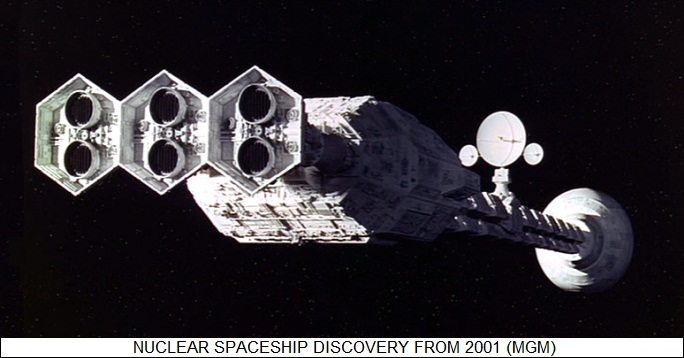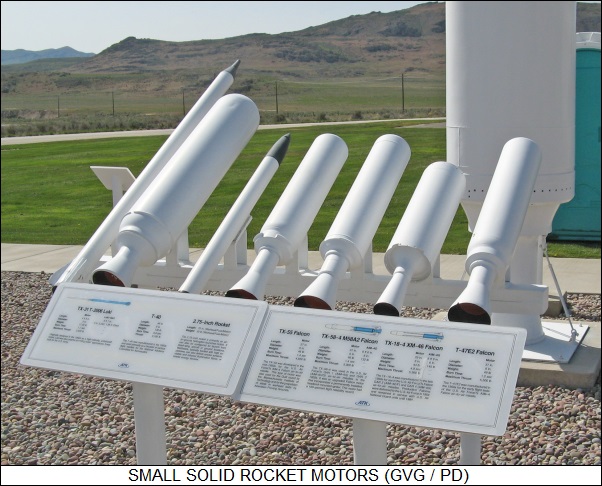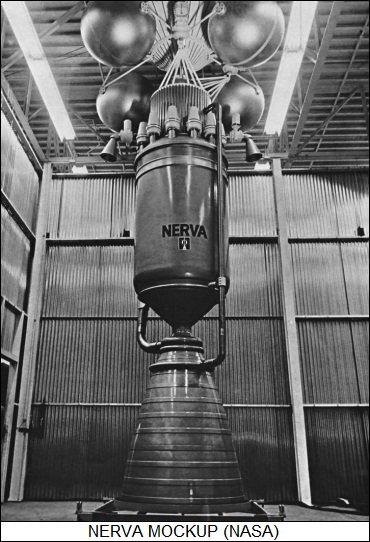
* In the postwar period, along with the refinement of liquid-fuel rockets, solid-fuel rockets became much more powerful and useful. Solid-fuel rockets would end up predominant in military applications, but they also proven useful for space exploration. This chapter surveys solid-fuel rockets.
* The fundamental form of all solid-fuel rockets is essentially the same. They contain propellant formed in a solid cylindrical block, or "grain", normally with a hole up the center to ensure uniform burning of the propellant. The hole can have a variety of configurations that give different "thrust profiles": for example, a cylindrical hole provides thrust that starts out low and increases as the hole widens, giving more area into the grain. Holes generally have configurations in the shape of various kinds of stars, which give the maximum area and thrust for initial burn. The hole is created by packing the fuel around a central "mandrel" piece that is removed after the packing is complete. A nozzle is generally attached to the base of the grain to provide better control of the exhaust.
The traditional solid propellant, invented by the Chinese in the Middle Ages, is "black powder", a mixture of a fuel composed of charcoal and sulfur, and an oxidizer consisting of "saltpeter" (potassium nitrate / KNO3). Black powder fireworks rockets are still in widespread use, since black powder does that job fine and is cheap. Conceptually similar military rocket projectiles were developed in World War II that used "double base" explosives, a combination of nitroglycerine and nitrocellulose (guncotton), as a propellant instead of black powder.
It is difficult, effectively impossible, to build a large rocket vehicle that uses black powder or double base explosives as a propellant. Such materials are both troublesome and dangerous to handle in large quantities. Another problem is that they burn very rapidly, providing high thrust for a short period of time. This is fine for simple, short range rocket projectiles, but not for putting payloads into space.
The first attempts to develop modern solid propellants were performed during World War II. American researchers developed small rockets that used asphalt as a fuel, mixed with potassium perchlorate (KClO4) as an oxidizer. This propellant provided lower thrust over a longer period of time. Asphalt was a poor binder, however, tending to crack at cold ambient temperatures, with the cracks interfering with the burning process; and to flow at high ambient temperatures, requiring the rockets to be stored nose-down. It also produced a great deal of black smoke, which caused particularly difficulties for use as "rocket assisted take-off (RATO)" boosters for aircraft. If one aircraft took off with RATO, the next following it would have to take off through a black haze that blocked the pilot's field of view.
After the war the Americans moved on to more sophisticated solid propellants, using synthetic polymers, particularly synthetic rubbers such as butadiene tire rubbers, mixed with ammonium perchlorate (NH4ClO4) oxidizer -- which provides higher performance than potassium perchlorate and burns cleaner -- and large proportions of powdered aluminum. The powdered aluminum burned at a high temperature, helping improve thrust. Use of high proportions of aluminum had been held up for some time because the conventional wisdom said that proportions greater than 5% wouldn't burn, but that turned out to be superstition when researchers ignorant of this "rule" tried higher proportions and found they got unprecedented levels of thrust. Later on, small proportions of iron oxide were included to provide a high-temperature "thermite reaction" with the aluminum powder. Modern solid fuels provide a specific impulse only a few percentage points below that of LOX-RP.
The fact that the propellant mix was based on rubberlike polymers allowed the "grain", or solid-rocket fuel element excluding the nozzle), to be cast in large blocks that resisted shrinkage or cracking, which would have affected the continuity of their burn at the very least and caused catastrophic failure at worst.

Electrical resistance heating wires could be inserted in the bottom of the grain as igniters. Since a safe solid fuel had a high ignition temperature, the wires sometimes ignited a primer element that had a lower ignition temperature, with this primer then igniting the grain. The primer might even have two "stages", with one element with a low ignition temperature igniting one with an intermediate ignition temperature, the second element then igniting the grain.
The central mandrel that defined the hole configuration for the desired flight thrust profile was coated with Teflon polymer to allow it to be removed from the cured grain. In the early days of solid fuel rockets, grease was used instead of Teflon, but the grease contaminated the solid fuel and that approach was abandoned.
Modern solid-fuel rocket engines are ideal for military applications. They can be stored almost indefinitely and aren't overly fussy about how they are handled, and they can be used and launched at any time with little preparation. Solid fuels are also denser than liquid fuels, allowing missiles to be more compact, if not that much lighter. This compactness was a particular plus for the development of solid-fuel long-range strategic nuclear missiles, since it allowed them to be stored in a smaller and cheaper missile silo, or be carried on a submarine.
Considerable effort was invested in the late 1950s to develop processes to manufacture the large grains for the "Minuteman" ICBM and the "Polaris" submarine-launched ballistic missile (SLBM). These processes were not trivial: the ammonium perchlorate oxidizer had to be very finely and uniformly milled; all the materials in the solid fuel recipe had to very uniformly mixed; and the grains had to be poured and then cured for several days in a vacuum environment to prevent bubbles from forming.
Work was also done to synthesize high-performance solid fuels, which included proportions of nitroglycerine and a particulate form of nitrocellulose, and in some cases a high explosive known as HMX as well. These high-performance mixes were unsurprisingly less stable and more troublesome in every respect than conventional mixes, and so they were only used for small final stages that were more easily handled.
The work on developing long-range solid-fuel missiles also led to technology for solid-rocket flight control, and for "thrust termination", or shutting down the engine of the upper stage so the warhead could separate and proceed on its proper trajectory to its target.
Small solid-fuel missiles can use fins for flight control, but that isn't practical for long-range missiles since they boost out of the atmosphere, making fins so much dead weight. A steerable nozzle can be used as with a liquid fuel engine, but a simpler scheme was adopted for the Minuteman and Polaris, using a pivoting ring around the lip of a fixed nozzle to redirect the thrust. The ring was known as a "jetavator". Later, inert freon gas was selectively injected into the throat of a fixed nozzle to deflect thrust. As far as thrust termination went, the problem was that once a solid rocket motor is lit, it burns to termination, and there's no way to shut it off. There is a way to cheat, however, by venting the thrust from the stage to the sides or forward so the warhead could continue on its way by itself.
These missile projects also led to the use of fiberglass for motor casings, reducing the weight of the rocket motor and so increasing payload. Fabricating large "filament wound" casings was troublesome, however, and so most casings were made of metal, usually steel, though lightweight titanium could be used when weight was an issue and cost not too painful an issue.
The size of solid-fuel grains grew by bounds through the 1950s, and by the early 1960s they were so big that they were becoming too bulky and heavy to handle and transport in any sensible way. To get around this problem of scale, a new technology, "segmentation", was developed in which the grains were fabricated as cylindrical segments, with the segments locked together in a single solid rocket motor using "lock rings". By the mid-1960s, segmented solid-rocket boosters (SRB) were being manufactured that could generate heavy thrust to help put increasingly large payloads into orbit.
BACK_TO_TOP* As with liquid-fuel rocket engines, trying to write a detailed history of solid-fuel rocket engines here would be impractical, and a short survey will have to do. The first modern solid-fuel rockets were developed in the late 1940s, for use as RATO boosters and to power relatively small missiles, such as air-to-air missiles (AAM). One particularly important set of examples of this period were the "T-41" and "T-42" solid rocket motors for the Hughes Falcon AAM, which would lead to the "Star" motor, used on the Thor Able-Star booster of the late 1950s as a final "kick" stage. A wide range of solid-fuel kick stages would be developed over the following decades.

The first large solid-fuel grain to be developed was the Thiokol "RV-A-10", with a diameter of 79 centimeters (31 inches) and a length of 4.37 meters (14 feet 4 inches). A refined variant was used for the Sergeant battlefield missile. There had been doubts up to that time that it was practical to built large solid-fuel rocket grains, but the RV-A-10 proved beyond doubt that it was possible.
The RV-A-10 led the way to the much larger grains for the three-stage Minuteman ICBM and the Polaris SLBM. The solid-rocket motor for the first stage of the Minuteman was an order of magnitude bigger than the RV-A-10, being 1.67 meters (5 feet 5.7 inches) in diameter and 7.42 meters (24 feet 4 inches) long. Both the Minuteman and Polaris had filament-wound final stages, though the first large-scale filament-wound stage had been flown on a Vanguard satellite launch vehicle in 1959. High-performance solid fuels were also introduced for the Minuteman and Polaris in later versions, and a later version of the Minuteman would also have a second stage with a titanium casing. Ironically, the US imported most of its titanium from the Soviet Union. Since there were very few civilian uses for titanium at the time, the Soviets had to be aware that it was mostly being used in American weapon systems that threatened the USSR.
Work on large solid-fuel grains for the Minuteman and Polaris programs also led to the development of the first all-solid-fuel space launch vehicle, the LTV "Scout", which would have a long career putting small payloads into space. In addition, the Minuteman development effort had a direct connection to the development of segmented solid rocket motors, with Aerojet testing the concept in 1961 by the simple measures of cutting a Minuteman first stage in half and then splicing it back together with a lock ring joint.
Both Aerojet and United Research, which would later become a component of the later United Technology Center (UTC), performed further work and static test firings of segmented rocket boosters. In 1962, UTC won a contract from the USAF to build a five-segment SRB for the Titan III space launch vehicle. The resulting SRBs went into service in 1965, with two SRBs straddling the liquid-fuel Titan core. The initial Titan III SRB motor was 3.05 meters (10 feet) in diameter and 25.8 meters (84 feet 8 inches) long. It led in the 1980s to the 5.5 segment motor for the Titan 34D and the subsequent 7 segment motor for the Titan IV, which produces about 7,565 kN (771,000 kgp / 1.7 million lbf) thrust per SRB.
The biggest solid-rocket motor ever to be put into operation started life as the SRB for the US space shuttle. Each SRB was 45.5 meters (149 feet 2 inches) long and had a diameter of 3.7 meters (12 feet), the segments being primarily of steel construction. The precise composition of the shuttle SRB grain by weight was:
The shuttle SRBs were made up of four segments stacked on top of each other. The hole up the center of the SRBs is cone-shaped at the bottom, leading to an 11-point star that runs to the top. This scheme gave maximum thrust of 11,770 kN (1.2 million kgp / 2.65 million lbf) at liftoff, falling off to a sustained level of thrust after that. The nozzle was steerable, with the SRBs recoverable by parachute.

The follow-on "Space Launch System (SLS)" leveraged off shuttle technology, notably the SRBs -- with the SLS SRBs having five segments instead of four, giving a total length of 54 meters (177 feet). These SRBs were put together from left-over shuttle SRB elements, and will be replaced by new SRBs with a composite casing.
In the US, solid rocket booster technology for spaceflight is now effectively monopolized by Orbital-ATK, the consolidated successor to earlier US solid-rocket companies. It continues to sell a range of different solid-rocket motors:
* As mentioned, one of the major weaknesses of the solid-fuel rocket is the fact that, once lit, it burns to completion, and the only thing that can be done is to divert the thrust when it is no longer needed. The lack of burn control for solid-fuel rockets has led to the development of "hybrid" rockets that use a solid-fuel core along with a liquid oxidizer. The solid fuel component in a hybrid rocket is not impregnated with large quantities of an oxidizer material, which makes the rocket much safer to handle and store since it cannot burn efficiently on its own.
Lockheed Martin has static-tested a hybrid motor with a butadiene-type solid fuel and liquid oxygen oxidizer. Lockheed Martin has also investigated the use of paraffins as propellants; "paraffins" in this case of course refers to the American usage of the term, meaning candle waxes and related solid hydrocarbons, and not the British usage of the term, which is what Americans call kerosene. Purdue University has performed small-scale experiments with hybrid rockets using a butadiene-based solid with storable hydrogen peroxide oxidizer.
Burt Rutan's commercial suborbital crewed spacecraft, "Spaceship One", used a hybrid propulsion system, with a butadiene-type solid fuel and nitrous oxide oxidizer. In this case, the propulsion system is designed for low cost and ease of handling instead of optimal thrust levels. Spaceship One is probably the first thing resembling an operational space vehicle to use hybrid propulsion; however, there doesn't seem to be much interest in doing more with the scheme.
* Experiments have also been performed on another approach to the same problem, in the form of "propellant gels". The idea is to take storable propellants and turn them into gels: hydrazine can be gelled by adding cellulose, and nitric acid can be gelled by adding silicon dioxide (sand, more or less). The results have the consistency of toothpaste. Aluminum powder can be added to provide more "kick".
Since hydrazine and nitric acid are hypergolic, if the two gels come in contact with each other they burn spontaneously -- but not for long, since a crust builds up between them that inhibits further combustion. This makes gels much safer to handle than their liquid forms. To get them to burn in a combustion chamber, they are fed under pressure through an orifice that turns them into an aerosol, allowing them to mix properly. The potential advantages of this approach are high energy density, throttleable operation, and relative safety in handling. Experiments have been performed in determining the suitability of gelled propellants for military missiles. The primary difficulty is that gelled propellants are more expensive than solid fuels.
* One of the more surprising schemes for solid fuel propulsion involved mixing nanoscale aluminum powder with water, and then freezing the mix into a slush. Surprisingly, the aluminum-ice ("ALICE") propellant burns and burns well, with the water combining with the aluminum nanopowder to form aluminum oxides and diatomic oxygen. The scheme was initially test-flown in 2009; work is being done towards additives that would make the fuel more efficient. The ALICE propellant is seen as interesting for "in-situ resource utilization", with a probe taking the aluminum powder to, say, Mars, and then mixing it with local water to boost a sample back to Earth.
Another interesting concept in solid fuel propulsion, devised by a British-Ukrainian team, is the "autophage" rocket -- which, instead of staging, simply consumes itself as it ascends, becoming shorter and shorter. The grain would consist of a propylene cylinder, presumably mixed with powdered aluminum, that would provide fuel and act as an airframe, with powdered oxidizer in the center, made of ammonium perchlorate and ammonium nitrate.
The grain itself would not burn. It would sit on top of a "vaporization surface", electrically heated to vaporize the propellants before they enter the combustion chamber of a rocket engine. As the rocket ascends, inertia forces the grain against the combustion surface, slowly consuming the grain. The rate of feed of the grain can be controlled, allowing the rocket to be throttled. The autophage scheme is not seen as very useful for large rockets, but it could mean cheap small ones. Nobody's flown an operational autophage rocket yet.
BACK_TO_TOP